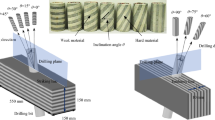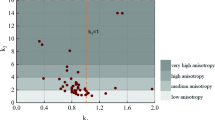Abstract
A numerical approach based on the particle discrete element theory is adopted to study the fracture evolution of transversely isotropic rocks with a pre-existing flaw under compression tests. In this approach, the rock matrix is simulated by parallel-bonded contacts and weak planes are represented as bonded contacts, and the acoustic emission characteristics of rock matrix and weak planes are obtained and distinguished using the moment tensor analysis. Firstly, the acoustic emission features of the numerical approach were validated against the test results. Then, parametrical studies were conducted to reveal the combined effect of pre-existing flaw and weak planes on the fracturing morphology of rocks, and six failure patterns were identified. Finally, the fracturing evolution process of each pattern was studied based on the moment tensor analysis.





















Similar content being viewed by others
References
Ambrose J (2014) Failure of anisotropic shales under triaxial stress conditions. Dissertation, Imperial College London
Bobet A, Einstein HH (1998) Fracture coalescence in rock-type materials under uniaxial and biaxial compression. Int J Rock Mech Min Sci 35:863–889
Chang LF, Konietzky H (2018) Application of the Mohr–Coulomb yield criterion for rocks with multiple joint sets using Fast Lagrangian Analysis of Continua 2D (FLAC2D) software. Energies 11:1–23
Chen YF, Wei K, Liu W, Hu SH, Hu R, Zhou CB (2016) Experimental characterization and micromechanical modelling of anisotropic slates. Rock Mech Rock Eng 49(9):3541–3557
Chong ZH, Li XH, Lu JZ, Chen T, Zhang J, Chen XY (2017) Numerical investigation of acoustic emission events of argillaceous sandstones under confining pressure. Math Probl Eng. ID: 7676417
Cruikshank KM, Zhao G, Johnson AM (1991) Analysis of minor fractures associated with joints and faulted joints. J Struct Geol 13:865–886
Dan DQ, Konietzky H (2014) Numerical simulations and interpretations of Brazilian tensile tests on transversely isotropic rocks. Int J Rock Mech Min Sci 71:53–63
Debecker B (2006) Influence of planar heterogeneities on the fracture behavior of rock. katholieke universiteit leuven, Leuven
Duan K, Kwok CY, Pierce M (2016) Discrete element method modeling of inherently anisotropic rocks under uniaxial compression loading. Int J Numer Anal Methods Geomech 40:1150–1183
Duan K, Wu W, Kwok CY (2018) Discrete element modelling of stress-induced instability of directional drilling boreholes in anisotropic rock. Tunn Undergr Space Technol 81:55–67
Esterhuizen GS, Dolinar DR, Ellenberger JL (2011) Pillar strength in underground stone mines in the United States. Int J Rock Mech Min Sci 48:42–50
Hazzard JF, Young RP (2000) Simulating acoustic emissions in bonded-particle models of rock. Int J Rock Mech Min Sci 37(5):867–872
Hazzard JF, Young RP (2004) Dynamic modelling of induced seismicity. Int J Rock Mech Min Sci 41(41):1365–1376
Itasca consulting group Inc. (2008) Particle flow code in 2 dimensions user’s guide. Itasca consulting group Inc., Minneapolis
Jin J, Cao P, Chen Y, Pu CZ, Mao DW, Fan X (2017) Influence of single flaw on the failure process and energy mechanics of rock-like material. Comput Geotech 86:150–162
Kim H, Cho JW, Song I, Min KB (2012) Anisotropy of elastic moduli, P-wave velocities, and thermal conductivities of Asan gneiss, Boryeong Shale, and Yeoncheon Schist in Korea. Eng Geol 147:68–77
Kim KY, Zhuang L, Yang H, Kim H, Min KB (2016) Strength anisotropy of Berea sandstone: results of X-ray computed tomography, compression tests, and discrete modeling. Rock Mech Rock Eng 49:1201–1210
Kulatilake PHSW, Malama B, Wang JL (2001) Physical and particle flow modeling of jointed rock block behavior under uniaxial loading. Int J Rock Mech Rock Min Sci 38:641–657
Lisjak A, Garitte B, Grasselli G et al (2015) The excavation of a circular tunnel in a bedded argillaceous rock (Opalinus Clay): short-term rock mass response and FDEM numerical analysis. Tunn Undergr Space Technol 45:227–248
Lockner DA, Byerlee JD, Kuksenko V, Ponomarev A, Sidorin A (1991) Quasi-static fault growth and shear fracture energy in granite. Nature 350(6313):39–42
Ma J, Wu SC, Zhang XP, Gan YX (2020) Modeling acoustic emission in the Brazilian test using moment tensor inversion. Comput Geotech 123. ID 103567
Manthei G, Eisenblatter J (2008) Acoustic emission in study of rock stability. In: Grosse C, Ohtsu M (eds) Acoustic emission testing. Springer, Berlin, pp 239–310
Morgan SP, Einstein HH (2017) Cracking processes affected by bedding planes in Opalinus shale with flaw pairs. Eng Fract Mech 176:213–234
Nasseri MHB, Rao KS, Ramamurthy T (2003) Anisotropic strength and deformational behavior of Himalayan schist. Int J Rock Mech Min 40(1):3–23
Niandou H, Shao JF, Henry JP, Fourmaintraux D (1997) Laboratory investigation of the mechanical behavior of Tournemire shale. Int J Rock Mech Min 34(1):3–16
Niu LX, Xin YY (2015) Analysis on relationship between macro-parameters and micro-parameters in PFC2D model based on orthogonal design: case of rock uniaxial compression numerical test. Yangtze River 46:53–57
Park B, Min KB (2015) Bonded-particle discrete element modeling of mechanical behavior of transversely isotropic rock. Int J Rock Mech Min Sci 76:243–255
Park JW, Song JJ (2009) Numerical simulation of a direct shear test on a rock joint using a bonded-particle model. Int J Rock Mech Rock Min Sci 46:1315–1328
Potyondy DO (2015) The bonded-particle model as a tool for rock mechanics research and application: current trends and future directions. Geosyst Eng 18:1–28
Potyondy DO, Cundall PA (2004) A bonded-particle model for rock. Int J Rock Mech Min Sci 41(8):1329–1364
Ramamurthy T (1993) Strength and modulus responses of anisotropic rocks. In: Hudson JA (ed) Comprehensive rock engineering, vol. 1. Fundamentals. Pergamon Press, Oxford, pp 313–329
Roya DG, Singh TN, Kodikara J (2017) Influence of joint anisotropy on the fracturing behavior of a sedimentary rock. Eng Geol 228:224–237
Shang J, Duan K, Gui Y, Handley K, Zhao Z (2018) Numerical investigation of the direct tensile behaviour of laminated and transversely isotropic rocks containing incipient bedding planes with different strengths. Comput Geotech 104:373–388
Song YL, Xia CC, Tang ZC, Song YJ (2013) Numerical simulation and test validation for direct shear properties of rough joints under different contact states. Chin J Rock Mech Eng 32:2028–2035 (in Chinese)
Teng JY, Tang JX, Zhang YN, Duan JC, Wang JB (2017) Damage process and characteristics of layered water-bearing shale under uniaxial compression. Rock Soil Mech 38:1629–1638
Tien YM, Kuo MC (2001) A failure criterion for transversely isotropic rocks. Int J Rock Mech Min 38(3):399–412
Wang YL, Tan JX, Dai ZY, Yi T (2018) Experimental study on mechanical properties and failure modes of low-strength rock samples containing different fissures under uniaxial compression. Eng Fract Mech 197:1–20
Wang DJ, Tang HM, Elsworth D, Wang CY (2019) Fracture evolution in artificial bedded rocks containing a structural flaw under uniaxial compression. Eng Geol 250:130–141
Wang Q, Zhang B, Guo SG, Han JG (2019) Effect of anisotropy, angle, and critical tensile stress and confining pressures on evaluation of shale brittleness index—part 1: methodology and laboratory study. Interpretation 7(3):637–646
Wei DM, Dai F, Xu NW, Liu Y, Zhao T (2018) A novel chevron notched short rod bend method for measuring the mode I fracture toughness of rocks. Eng Fract Mech 190:1–15
Wei DM, Dai F, Xu NW, Zhao T (2016) Stress intensity factors and fracture process zones of ISRM-suggested chevron notched specimens for mode I fracture toughness testing of rocks. Eng Fract Mech 168:174–189
Wei DM, Dai F, Xu NW, Zhao T, Liu Y (2017) An experimental and theoretical assessment of semi-circular bend specimens with chevron and straight-through notches for mode I fracture toughness testing of rocks. Int J Rock Mech Min Sci 99:28–38
Wigand M, Carey JW, Schütt H, Spangenberg E, Erzinger J (2008) Geochemical effects of CO2 sequestration in sandstones under simulated in situ conditions of deep saline aquifers. Appl Geochem 23:2735–2745
Wong LNY (2008) Crack coalescence in molded gypsum and Carrara marble. Degree thesis, Massachusetts Institute of Technology
Wong LNY, Einstein HH (2009) Systematic evaluation of cracking behavior in specimens containing single flaws under uniaxial compression. Int J Rock Mech Min Sci 46:239–249
Xia L, Zeng YW (2018) Parametric study of smooth joint parameters on the mechanical behavior of transversely isotropic rocks and research on calibration method. Comput Geotech 98:1–7
Yang SQ, Huang YH, Tian WL, Zhu JB (2017) An experimental investigation on strength, deformation and crack evolution behavior of sandstone containing two oval flaws under uniaxial compression. Eng Geol 217:35–48
Yang SQ, Jing HW (2011) Strength failure and crack coalescence behavior of brittle sandstone samples containing a single fissure under uniaxial compression. Int J Fract 168:227–250
Yong S, Kaiser PK, Loew S (2013) Rock mass response ahead of an advancing face in faulted shale. Int J Rock Mech Min Sci 60:301–311
Zhang XM (2010) Experimental study on anisotropic strength properties of sandstone. Electron J Geotech Eng 15:1325–1335
Zhang XP, Wong LNY (2013) Loading rate effects on cracking behavior of flaw-contained specimens under uniaxial compression. Int J Fract 180:93–110
Zhang XP, Zhang Q (2017) Distinction of crack nature in brittle rock-like materials: a numerical study based on moment tensors. Rock Mech Rock Eng 50:2837–2845
Zhang Q, Zhang XP (2019) The crack nature analysis of primary and secondary cracks: a numerical study based on moment tensors. Eng Fract Mech 210:70–82
Acknowledgements
This research was supported by Regional Joint Fund for Basic and Applied Basic Research Fund of Guangdong Province (2019A1515110836). The opinions expressed in this paper are those of the authors and not of the funding agencies.
Author information
Authors and Affiliations
Corresponding author
Ethics declarations
Conflict of interest
The authors declare that they have no conflicts of interest.
Additional information
Publisher's Note
Springer Nature remains neutral with regard to jurisdictional claims in published maps and institutional affiliations.
Appendix
Appendix
Rights and permissions
About this article
Cite this article
Xu, G., Hu, X., Tang, R. et al. Fracture evolution of transversely isotropic rocks with a pre-existing flaw under compression tests based on moment tensor analysis. Acta Geotech. 17, 169–203 (2022). https://doi.org/10.1007/s11440-021-01214-9
Received:
Accepted:
Published:
Issue Date:
DOI: https://doi.org/10.1007/s11440-021-01214-9




